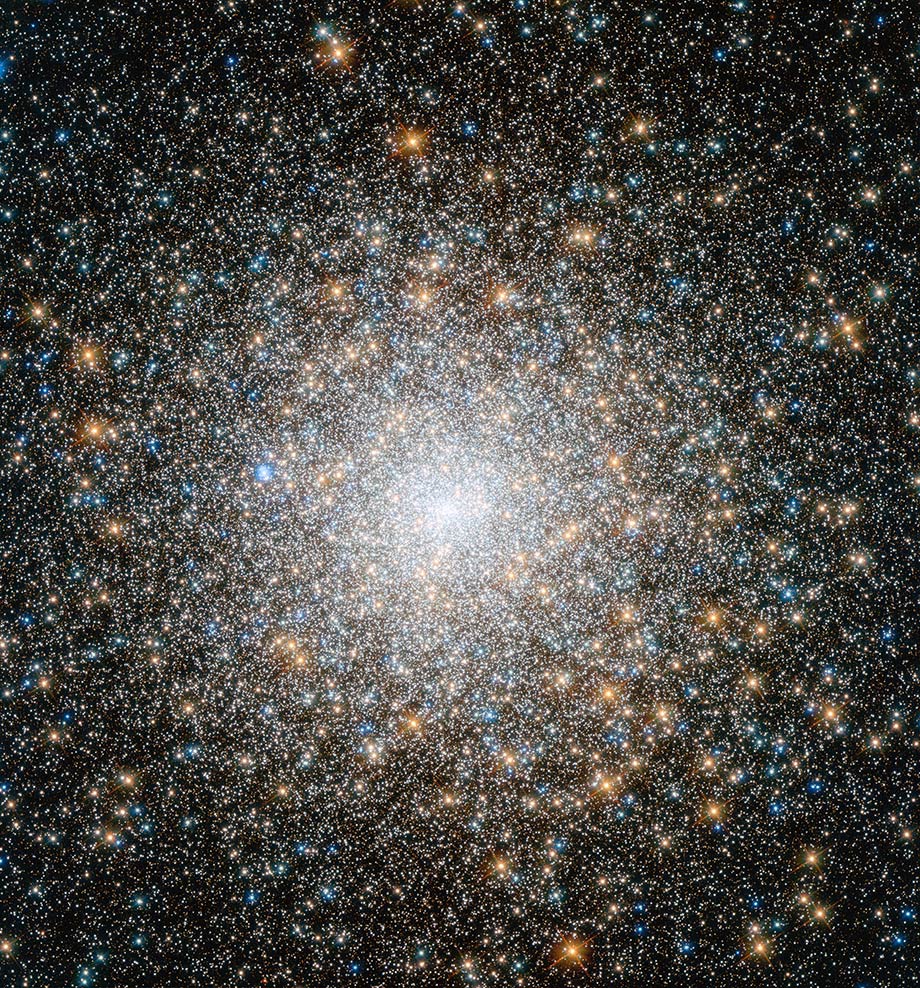The Best Astronomy and Space Pictures of 2013
Two dozen of the finest views of our Universe from the past year.
I love astronomy. I have my whole life. Part of that is the wonder and awe it generates, learning about the Universe and our place in it.
But of course, there is great beauty in the skies as well. From our nearest neighbors to the most distant galaxies, the cosmos is a wonder to behold. Every year I collect my favorite pictures—chosen both for their beauty and their importance to science—and put them together in a gallery to delight your brain (you’ll find links to previous galleries at the end of this article). Picking only a few is always a herculean task, but I hope the ones on this list affect you the same way they did me.
Note: With some images, I’ve included a link to a “runner-up,” a great photograph from the past year similar to the one chosen; a little extra icing on the cake for you at the end of the year.
A Buzzing Beehive of Stars
Globular clusters are among my favorite objects in the sky: ball-shaped collections of hundreds of thousands or even millions of stars held together by their mutual gravity. In most cases, the stars in them were all born at the same time, so they are also laboratories for scientists to study how stars age. This photo of M15 by Hubble Space Telescope shows just how multihued and tightly packed they can be; 100,000 stars call this globular cluster home even though it’s only 200 light years across. Located in the constellation of Pegasus, it’s bright enough to be easily seen in small telescopes, and I remember many a winter’s night peering at it through my own ‘scope when I was a young lad. However, it didn’t look like this!
Runner-up: Globular Cluster 47 Tuc in the Infrared
Digging Very, Very Deep Into a Nearby Galaxy
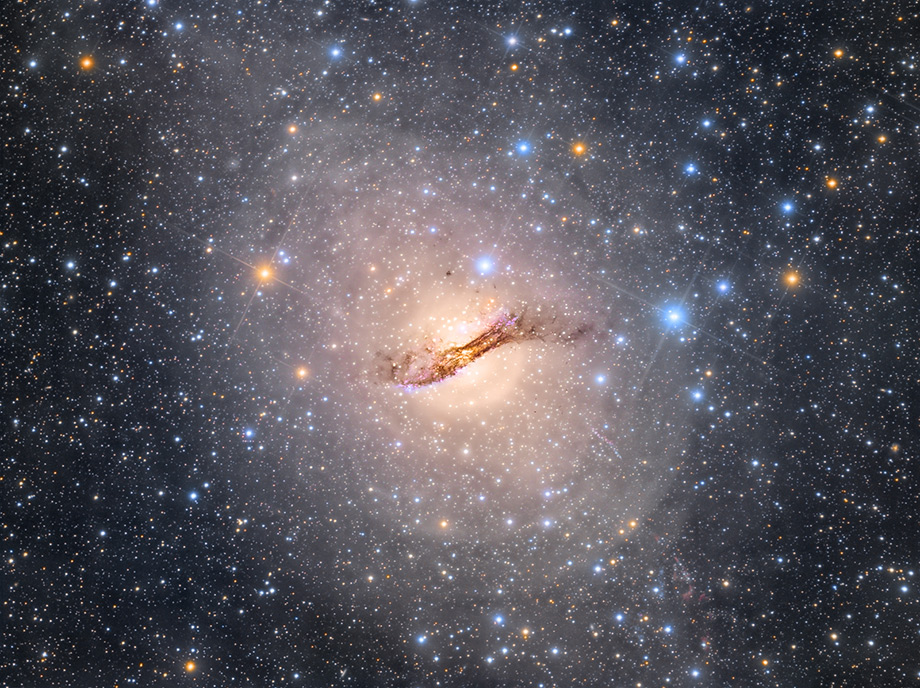
Photo by Rolf Olsen
The line between a professional and amateur astronomer has been narrowing for years and is now so thin it’s practically gone. Rolf Olsen is an “amateur” astronomer in New Zealand who uses a telescope with a 25 cm (10 inch) mirror to take astonishing images of the southern skies. This image of the nearby galaxy Centaurus A is the result of adding together exposures totaling an incredible 120 hours over 43 nights! The galaxy itself is a mess; it has suffered multiple collisions with other galaxies, creating massive chaos. The dark lane across the center, the huge shells of material around it, and the (barely visible to the upper left and lower right) jets of gas screaming out from the galaxy’s central black hole are all consequences of its violent past.
Martian Latte
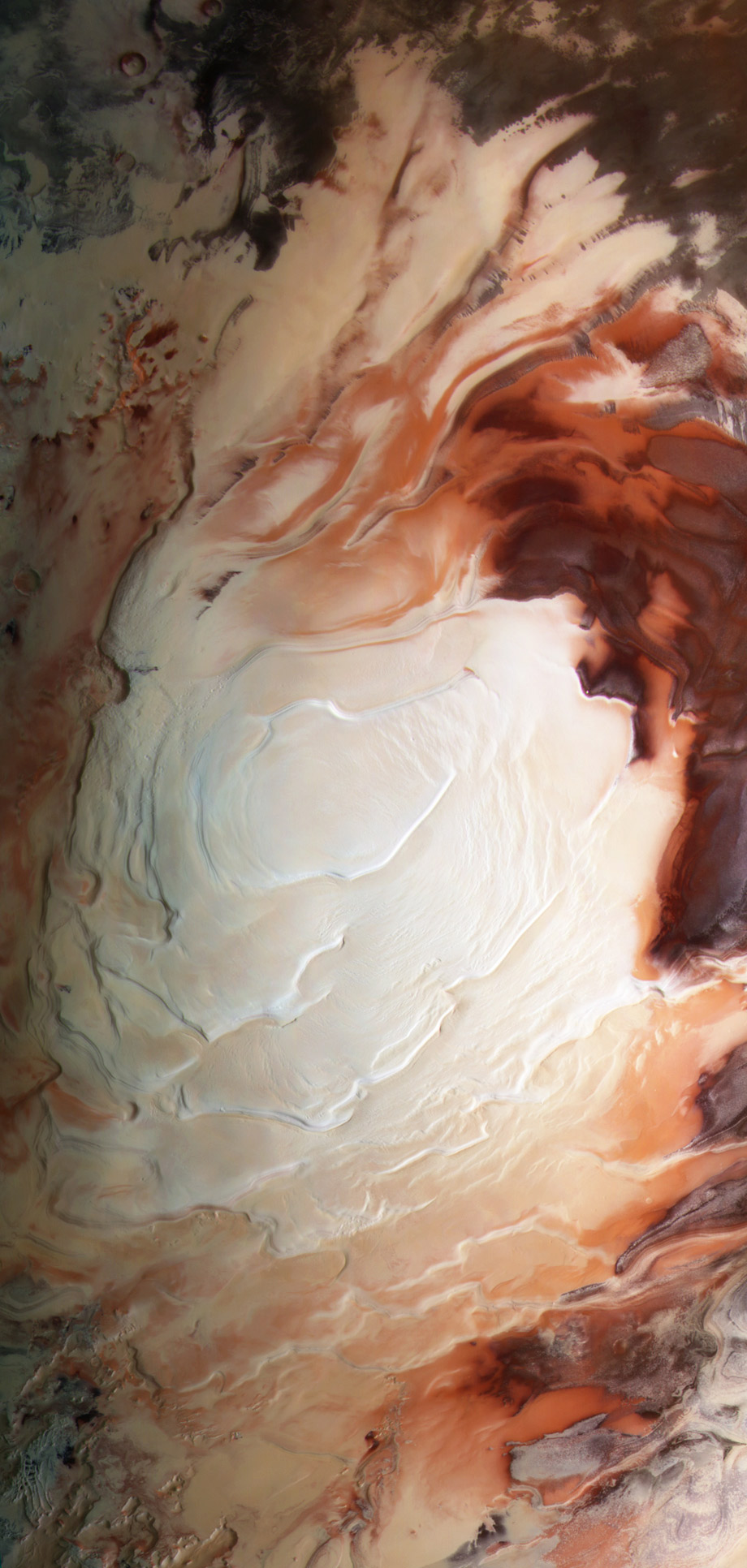
Photo by ESA/G. Neukum (Freie Universitaet, Berlin)/Bill Dunford
The Mars Express orbiter has been circling the fourth rock from the Sun for 10 years now, taking thousands of observations. Bill Dunford collected quite a few of those images and created this jaw-dropping mosaic of the south pole of Mars. It’s not quite what the eye would see; what’s shown as red is actually near infrared, invisible to us but easily seen by the camera on the spacecraft. Kilometers-thick water ice covers the pole, capped itself by a layer of carbon dioxide ice a few meters thick. That is mixed with the rusty dust eternally blowing in the Martian winds, creating what looks more like something you’d order at a coffee shop rather than the frigid nether regions of a nearby world.
Runner-up (what else?): Mars Express Image of the Martian North Pole
The Knight That Rules the Night
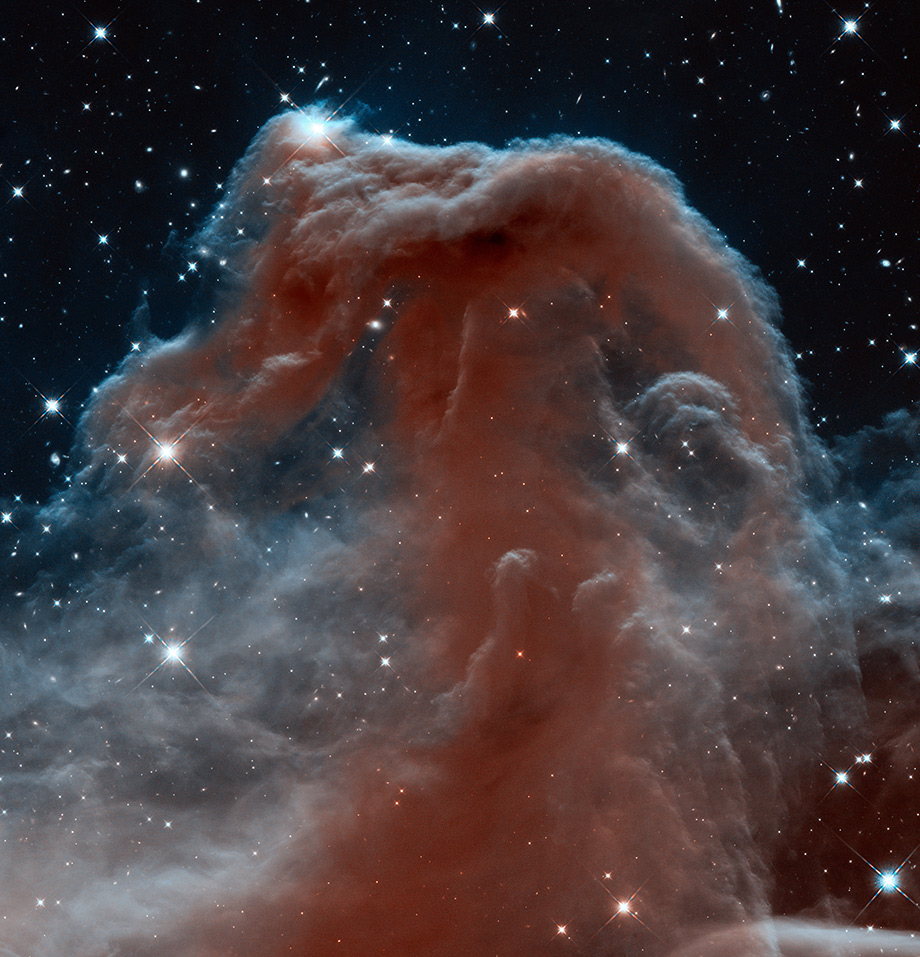
Photo by NASA, ESA, and the Hubble Heritage Team (STScI/AURA)
April 24, 2013, was the 23rd anniversary of the launch of the Hubble Space Telescope into orbit. To commemorate this event, the folks at the Space Telescope Science Institute released this image of the Horsehead Nebula, named for somewhat obvious reasons. Located just next to Orion’s belt, this cloud of dust and gas is a region where stars are forming. When viewed in visible light the Horsehead appears dark, a cosmic chess piece silhouetted against pink and red glowing gas. In infrared light, as in this image, the dust becomes visible, delicate billows of clouds surrounding baby stars just getting their start in the Universe. Better take a look while you can: In a few million years all this will be gone, eroded away by the fierce light of the nearby powerhouse star system Sigma Orionis.
Runners-up: Crab Nebula Video Shows Gas Cloud Expanding Over Time and Twin Baby Stars Belch into Their Mama’s Face
Saturn, From High Above
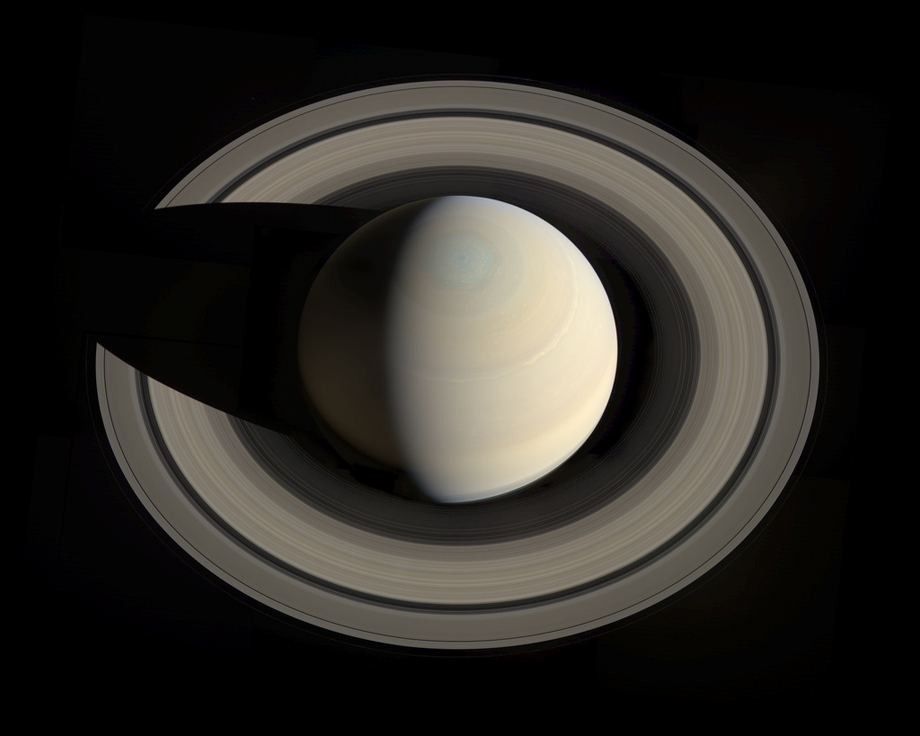
Photo by NASA/JPL/Space Science Institute/Gordan Ugarkovic
Did you know that all of the pictures from NASA’s Cassini Saturn probe are public? That means anyone can peruse the archive of raw images and use them to create their own pictures. Gordan Ugarkovic is software developer and something of a genius artist when it comes to image processing. The proof is in this staggeringly beautiful mosaic he created of Saturn seen from above its north pole. Composed of three dozen separate exposures, this near-true-color portrait has stunning detail. You can see the hexagonal north polar vortex, the remnants of a monster storm in the northern hemisphere, and of course Saturn’s magnificent rings, gaps and all. And as amazing as this is, you must see it in all its 4000x3200 pixel glory. And you’re welcome for your new computer desktop image.
Saturn, From Far Behind
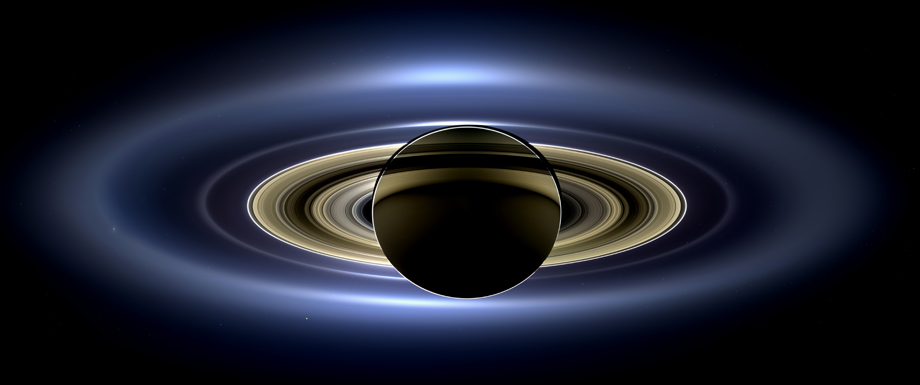
Photo by NASA/JPL/Space Science Institute
On July 19, 2013, the Cassini spacecraft moved into a part of its orbit where it was behind Saturn, the giant planet blocking the light from the distant Sun. Over the course of four hours Cassini snapped dozens of images in different filters, mapping out the entire planet, its moons and rings, and even distant stars in the background. The result is this jaw-dropping mosaic, which I had to shrink substantially to fit the width of this article. You must grab the full-res version, a bandwidth-choking 9000x3500 pixels in size. But it’s only in that image you can see the tremendous detail available … including a small spot, just a barely glowing ember, really, hanging below and to the right of Saturn’s disk. That meager dot, invisible in the image above and only barely glimpsed in the big version, is our entire planet. From a distance of 1.4 billion (900 million) kilometers, the Earth is reduced to a spark in the night sky, our hustle and bustle and worries and hopes and fears and soul-drenching loves and unfathomable hates and bloody wars and heartfelt charity, all compacted into a handful of pixels, a fuzzy blob containing all of humanity. The Universe is massive and cold and distant, but its beauty is inherent, and the joy of it, even when we seem insignificant, is that we can appreciate it at all.
A Dying Star Rages Into the Night
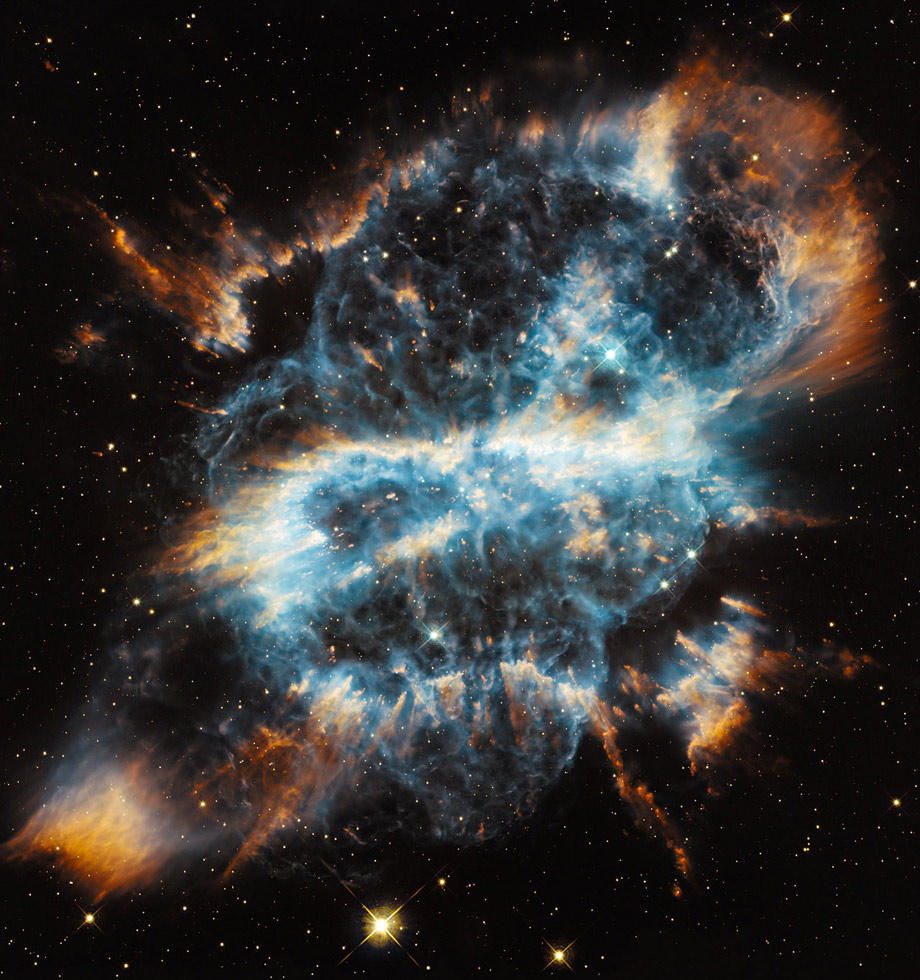
Photo by NASA, ESA, and the Hubble Heritage Team (STScI/AURA)
When stars die, they do it in style. This is NGC 5189, a glowing gas cloud seen by the Hubble Space Telescope. At the center is a white dwarf, the remains of what was once a star probably about twice the mass of the Sun. As it ran out of fuel, it expelled huge quantities of gas into space, exposing its dense core. White hot, spinning rapidly and possessed of a killer magnetic field, the white dwarf spewed out twin jets of energy and matter from its poles, energizing the surrounding material. However, the star is wobbling, so these lighthouse-like beams appear to carve out a gigantic S shape in the star’s former outer layers. At least, we think that’s what’s happening: This object isn’t completely understood, though that’s is the most likely explanation for this dramatic and lovely object.
Runner-up: Hubble’s High-Res View of the Ring Nebula
The Cold, Fiery, Dusty Arms of Andromeda
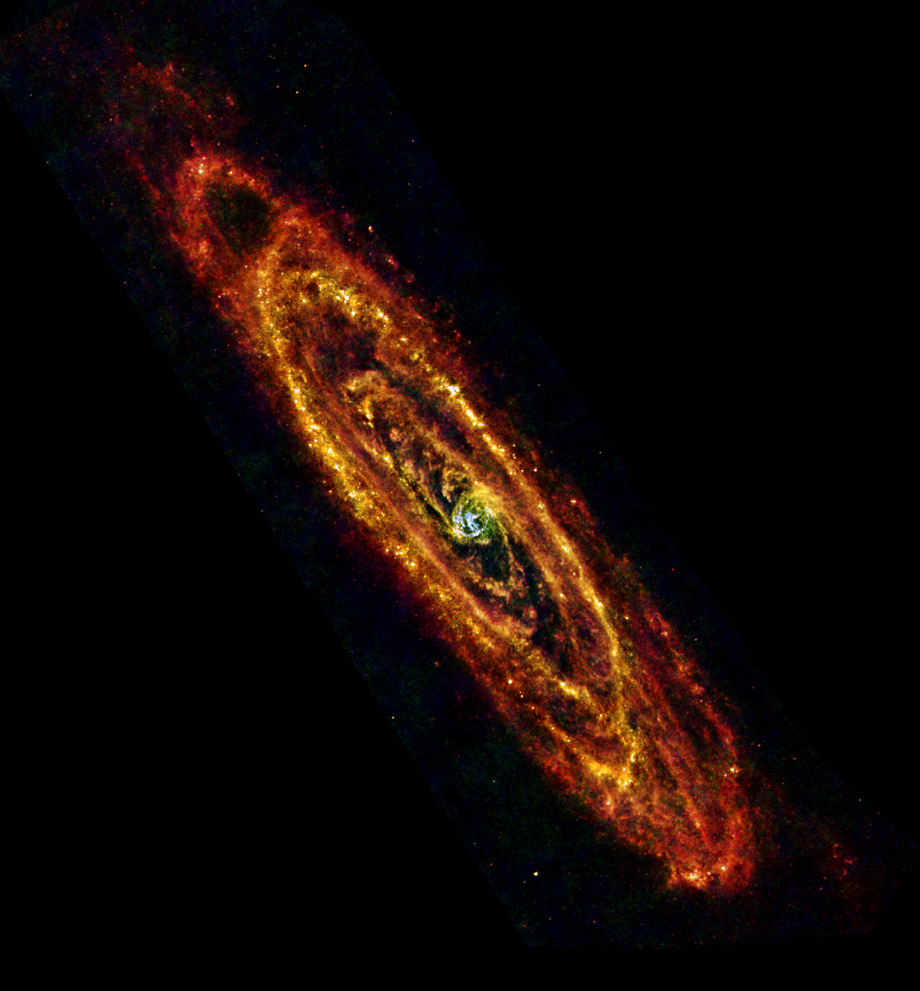
Photo by ESA/Herschel/PACS & SPIRE Consortium, O. Krause, HSC, H. Lin
The Andromeda galaxy is the nearest big spiral to our home galaxy, the Milky Way. It’s actually a bit bigger than we are, and like our galaxy has vast spiral arms where stars are born. This process creates huge quantities of what astronomers call dust—actually a complex organic molecule similar to soot. This dust is warmed by the massive stars forming nearby, causing it to glow in the infrared. The European Space Agency’s Herschel observatory captured this eerie light, mapping out Andromeda’s far-flung arms. This image is taken in the far-infrared, well outside what our human eyes can see. And while astronomers call this dust warm, by normal people standards it’s frigid beyond imagining: The hottest dust you see in this image is actually at a temperature of -232 C (-385 F)!
On April 29, 2013, the Herschel Observatory closed its eyes; it was shut down after running out of the liquid helium it needed to cool its detectors. Its mission lasted more than three years, providing a critical view of the cosmos in the far-infrared.
Runner-up: Hubble Image of an Odd Spiral
The Folly of Humanity
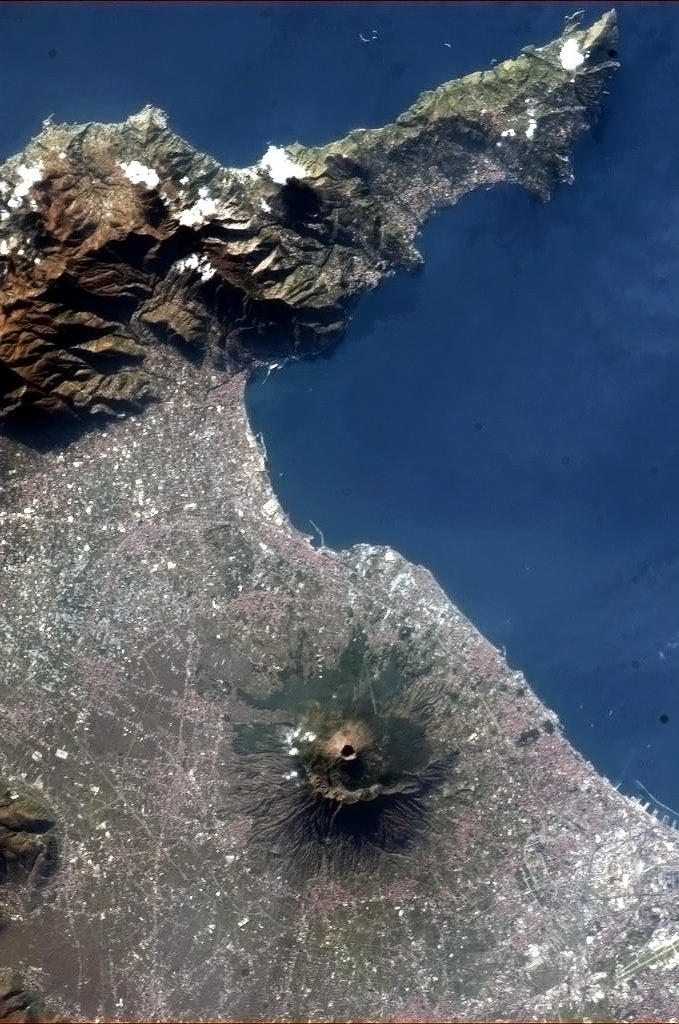
Photo by NASA
In 79 A.D., Mount Vesuvius exploded with the energy of a thousand nuclear bombs. It killed something like 16,000 people as rock and ash poured out of it at a rate of more than a million tons per second. It was so devastating that it has become an icon of the terror of an active volcano.
1934 years later, astronaut Chris Hadfield took this photo of the sleeping monster from over 300 kilometers above it. As you can see, the volcano is located just 9 kilometers (5.5 miles) east of Naples, Italy, with a population of more than 3 million people, making Vesuvius one of the most dangerous volcanoes on the planet. I’m fascinated by volcanoes, and I love pictures of them taken from orbit. But looking at this photo, and knowing it erupts on average every few decades, I have to wonder: What are the people who live there thinking?
The Mustache to the Stars
Speaking of Chris Hadfield, the be-mustached astronaut took so many great pictures and did so many amazing things during his six-month stay on the International Space Station that I agonized over which one to include. Somehow, though, I simply couldn’t resist including this video by him. You’ve probably seen it; as I write this, it’s been viewed 19 million times. Still, his cover of David Bowie’s “Space Oddity” is worth watching again. You can get the wonderful backstory behind the making of the video in Hadfield’s interview with Nerdist’s Chris Hardwick. Also? Go read Hadfield’s book. You’ll be better for it.
Year of the Comet, Part 1
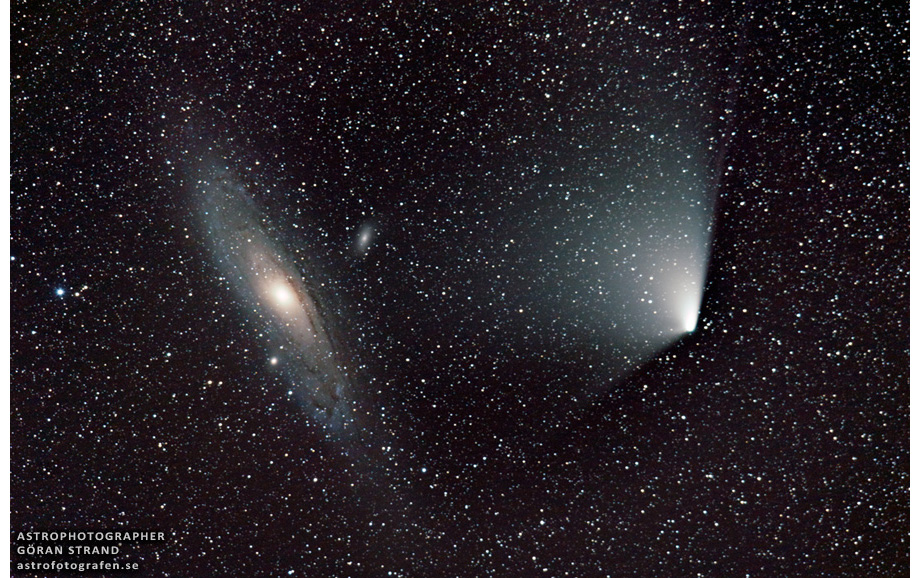
Photo by Göran Strand
2013 saw a barrage of comets invading the inner solar system, but two stood out among the rest: C/2012 S1 (ISON) and C/2011 L4 (Pan-STARRS). Pan-STARRS came around first, appearing in our skies in the spring. I saw this comet myself over the course of several nights, when it was in the northwest after sunset. I managed to snap a few pics, but nothing like this one by Swedish astrophotographer Göran Strand, who took it on April 4, 2013, from north of Östersund, Sweden. The grace and beauty of the comet are lovely to behold, only amplified by appearing next to the Andromeda galaxy—though that’s a matter of perspective. At the time, the comet was 200 million kilometers away, while Andromeda is 25 quintillion kilometers distant.
Year of the Comet, Part 2
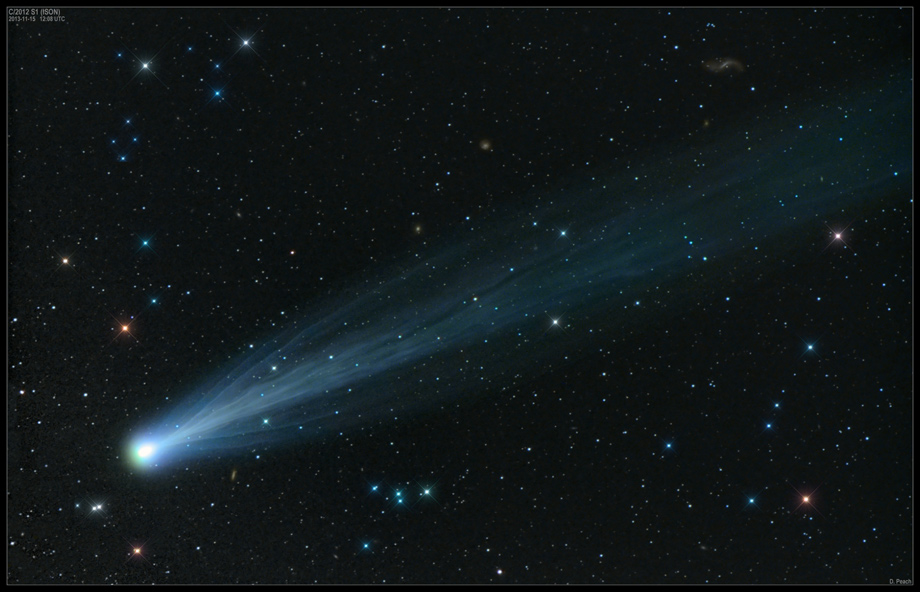
Photo by Damian Peach
The second comet in this year’s list is none other than ISON. It may have disintegrated as it rounded the Sun—honestly, it’s amazing any comet can survive such a brutal gantlet—but on approach it was the picture of a perfect visitor. The image here, by Damian Peach, was taken on Nov. 13, 2013, not long before the end. The tail of the comet stretched for tens of millions of kilometers, and its interaction with the solar wind brought out wiggles and filaments that belied its eventual fate: an expanding cloud of dust as it rounded our star.
Runner-up: The Comet and the Galaxy
The Sound of Thunder Over Russia
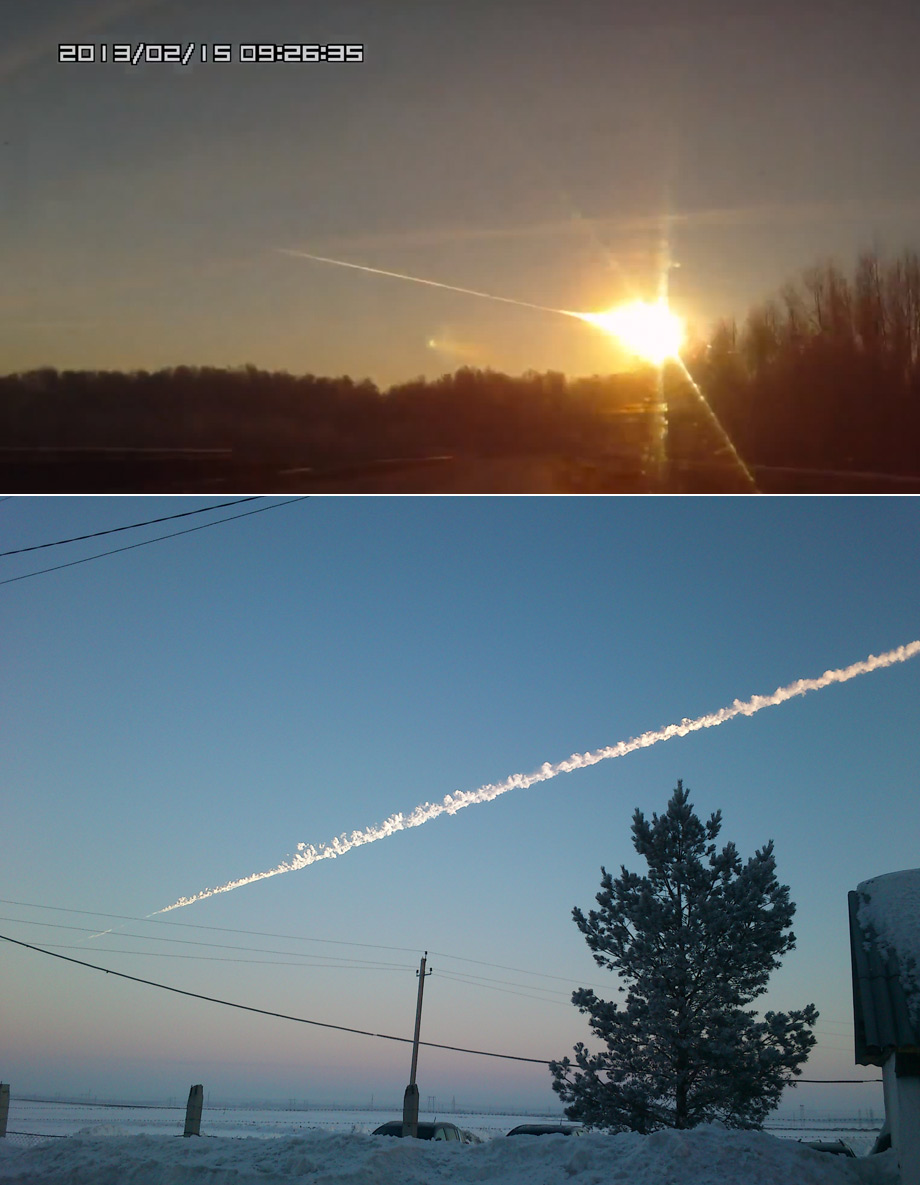
Photo by Евгений Славенков (fireball, top); Константин Кудинов (vapor trail, bottom)
On the morning of Feb. 15, 2013, residents of the Russian city of Chelyabinsk got a very rude awakening: the flash of light and thunderous impact of a 19-meter-wide, 12,000-ton asteroid detonating in our atmosphere as it rammed through the air at more than 70,000 kilometers per hour.
The heat began to melt the asteroid’s rocky material and blow it off when it was still nearly 70 kilometers above the ground, leaving a long vapor trail across the sky. Its huge energy of motion was rapidly converted into light and heat, so sudden it was by all definitions an explosion, the equivalent of half a million tons of TNT detonating. The shock wave swept downward, taking nearly a minute to reach the heavily populated city of Chelyabinsk, where it slammed into buildings, shattering windows, and injured more than a thousand people (mostly due to flying glass). Small bits of the asteroid rained down over the countryside, but one chunk a half-meter across and weighing 570 kilograms slammed into a frozen lake, where it was later recovered. That will prove a boon to scientists studying impacts.
The Chelyabinsk impact may have been the single most important astronomical event of the year. It was a sharp reminder that the Earth sits in a cosmic shooting gallery, and we need to take the threat of asteroid impacts seriously.
Equinox Earth
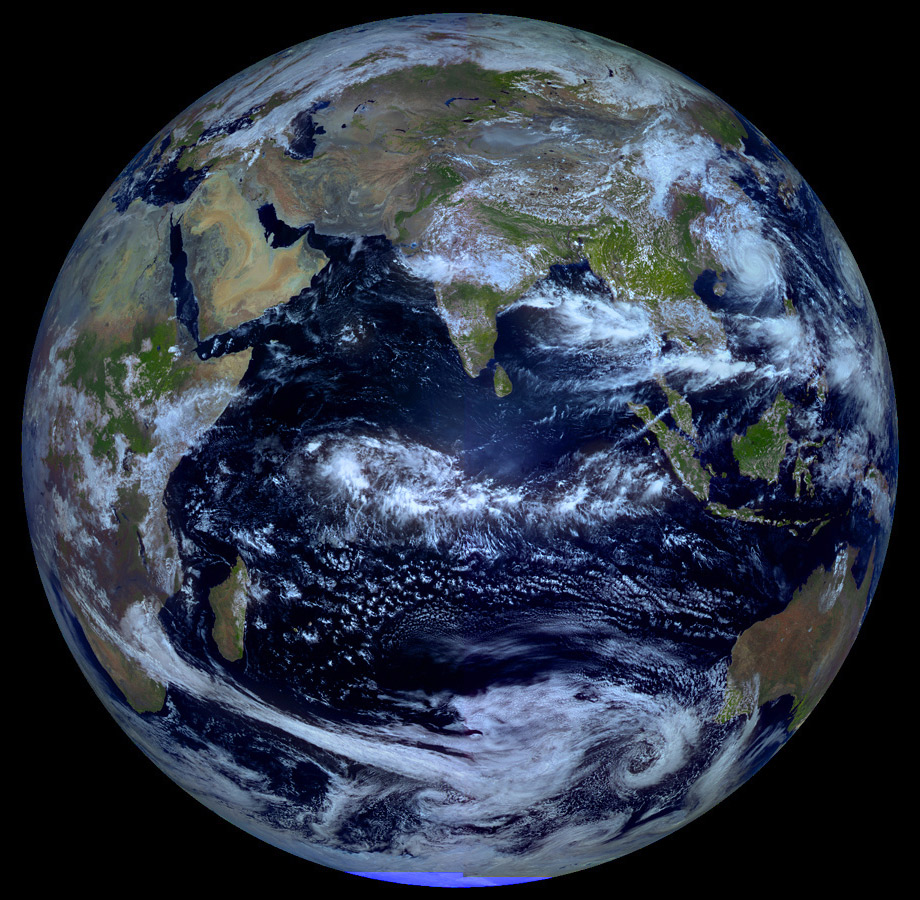
Photo by Roscosmos/NTSOMZ/SRC "Planeta"/zelenyikot.livejournal.com
The Earth is a tilted top, spinning at an angle (about 23 degrees) as it orbits the Sun. Because of this there are only two times a year when both hemispheres receive light from pole to pole: the equinoctes (the plural of “equinox”). These occur on or around March 22 (generally called the vernal equinox) and Sept. 22 (the autumnal equinox). At 05:30 UTC on Sep. 22, 2013—just hours before the actual moment of the equinox—the Russian weather satellite Elektro-L took the photo above, showing our evenly lit planet. You can see a typhoon off the coast of China, winds streaming east from southern Africa, the deep blue oceans, green vegetation (actually taken using an infrared camera, which highlights plants), and the brown deserts.
Journalist and space enthusiast Vitaliy Egorov put together a series of images taken from Sep. 20–21 to create the animation above, which shows the Earth in motion. The satellite orbits once every 24 hours, so the face of the Earth seems to stay still as the day/night line (called the terminator) sweeps across it—you can also see sunglint, the reflection of the Sun off of water, moving across the ocean as well. Our planet, when seen the right way, is mesmerizing.
The Horns of an Eclipse

Photos by Colin Legg and Geoff Sims (top), and Teoh Hui Chieh (bottom)
Original blog post (top photo), Original blog post (bottom photo)
On May 10, 2013, the Moon passed directly in front of the Sun. Normally, this would result in a total solar eclipse but for a vagary of orbital mechanics: It happened when the Moon was near apogee, the point in its orbit when it’s farthest from Earth. That makes the Moon look a bit smaller, so it cannot completely cover the Sun. At maximum eclipse, a ring of solar surface circles the dark silhouette of the Moon. This is called an “annular” eclipse. Folks in Australia had the best view of the event, especially in the west, when the Sun and Moon rose already amidst their dance. The top photo is by Colin Legg and Geoff Sims, part of a time-lapse animation they filmed in the Pilbara region of Western Australia. The bottom picture is part of another time-lapse animation taken by Teoh Hui Chieh in Kumarina, Western Australia. Her location, south of Legg and Sims, changed the geometry of the eclipse so it rose not quite at maximum, leaving the Sun looking like a set of horns rising menacingly over the horizon. In both, you can see how the Earth’s atmosphere acts like a lens, squashing the Sun near the horizon.
Moonrise Sonata
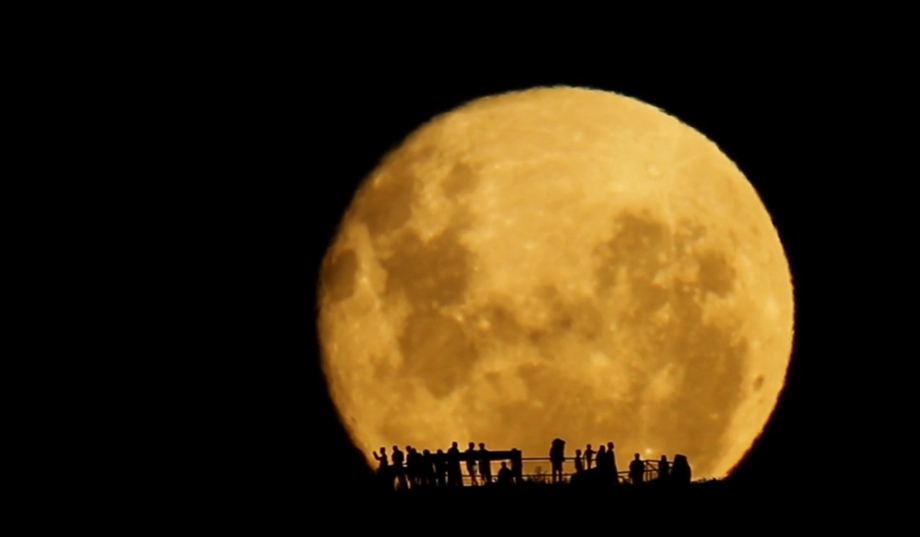
Photo by Mark Gee
One of the more remarkable aspects of the dance of astronomical objects in our sky is their predictability. With the right software you can know the exact time and position on the horizon where the Moon will rise from any given location with exquisite accuracy. Mark Gee knew that people gathered at a specific place to watch the Moon rise on Mount Victoria in Wellington, New Zealand, so he camped out about 2 kilometers away, set up his camera with a powerful telephoto, and waited. It took several tries, but he was able to take the photo above that is actually just one frame from a mesmerizing video he made of the Moon rising in real time. You simply must watch it; there is something enthralling about the slow and graceful rise of the Moon with the people silhouetted in front of it. It’s one of the most remarkable astronomical videos I saw all year.
E.T. Over the Moon
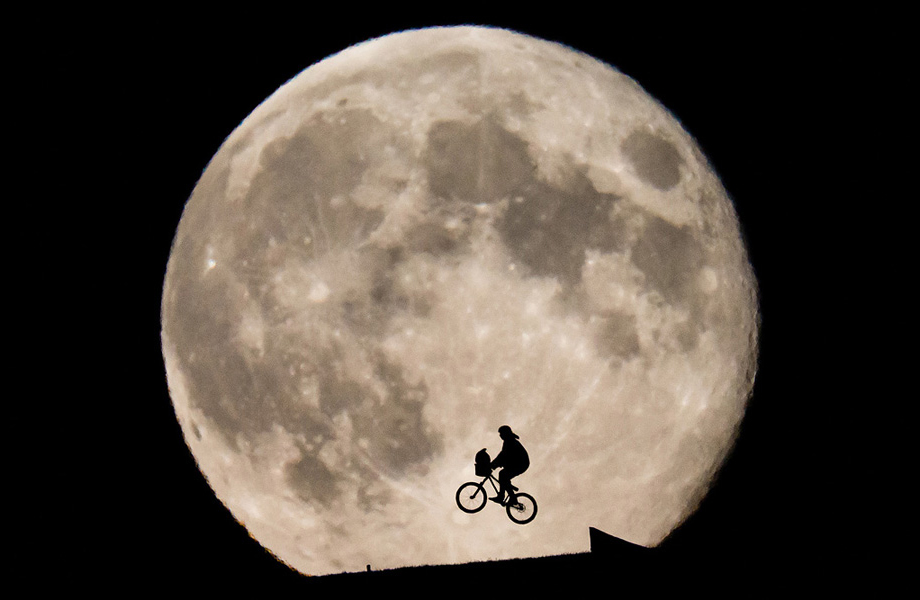
Photo by Philipp Schmidli
As with the photo above of people silhouetted on the rising Moon, photographer Philipp Schmidli saw a similar opportunity. He had already taken some photos of a friend biking in front of the Moon that had turned out well (again, using sophisticated mapping and planetarium software to precisely plan the shoot). After that photo went viral on the Net, several folks pointed out how much it looked like the iconic scene from the movie E.T. the Extra-Terrestrial, when Elliott and the alien fly across the face of the Moon. So he figured, why not? More planning, more scheduling, more setup, and a few months later he was able to recreate the scene that inspired a generation of moviegoers.
The Universe Is a Little Older Than We Thought
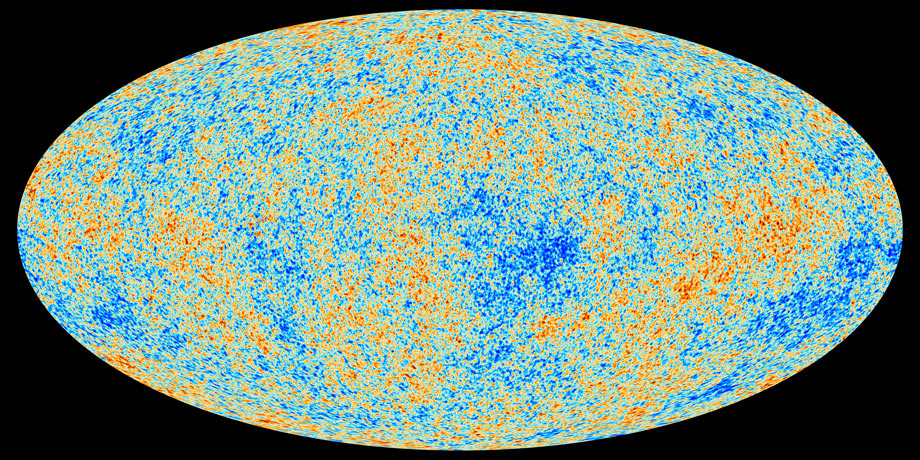
Photo by ESA and the Planck Collaboration
The Universe is old, but how old? We’ve only been able to answer that question with any accuracy at all in the past few decades, and as we use different methods to measure it, we hone in on the right answer. The European Space Agency’s Planck observatory scanned the skies, looking for minute variations in ancient light from when the Universe was young (shown in the picture above; red is from slightly hotter spots, blue from cooler); astronomers can analyze the pattern to determine quite a bit about the cosmos in which we live. These tiny fluctuations tell a huge story: The Universe is 13.82 ± 0.12 billion years old. They also show the Universe is expanding a tad slower than we previously thought, and that 95.1 percent of the Universe is made of stuff we cannot see, yet still affects us profoundly: dark energy and dark matter. Getting more accurate numbers for all these quantities helps scientists understand just how we got where we are … in a Universe filled with amazing stuff, able to understand and appreciate it at all.
And you should know: Its mission complete, Planck was shut down in October 2013 after more than four years of probing the early Universe.
China on the Moon
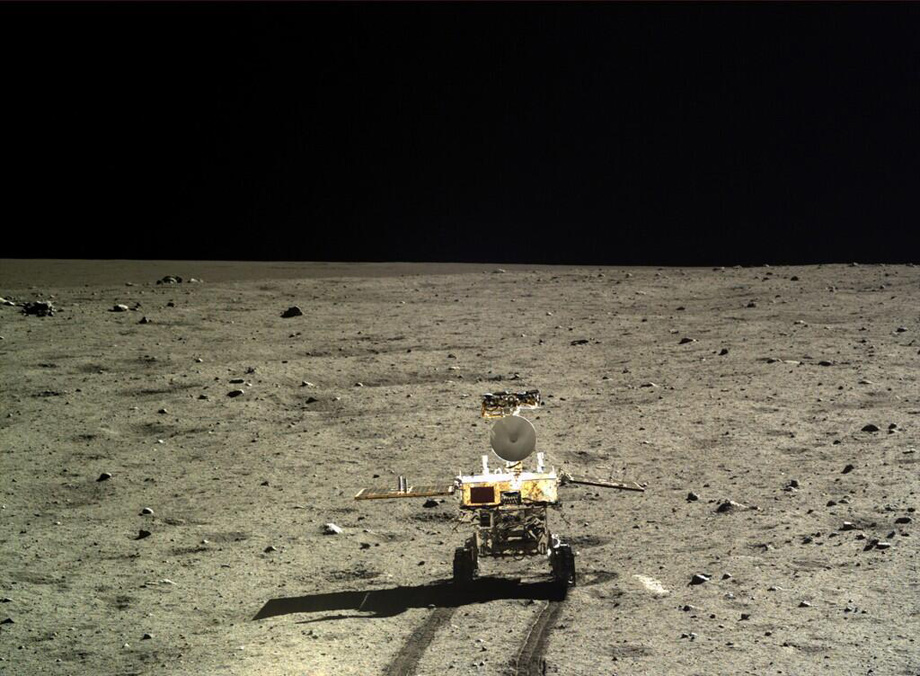
Photo by CNSA/CCTV
On Dec. 14, 2013, the Chinese mission Chang’e 3 set down on the Moon; the first soft landing of a robotic mission since 1976. Within a few hours of touchdown, the rover Yutu (“Jade Rabbit”) rolled off the lander, ready to begin its exploration of the surface. China has been making a lot of progress in space exploration over the past few years, including the launch of three crewed (though temporary) space stations. They have clear plans to put a human on the Moon, perhaps as soon as the mid-2020s. My fervent hope is that this sparks a new era in space exploration where nations cooperate, or at least compete on friendlier terms than a full-blown space race. Take a moment to watch this amazing HD video created from images of the lander as it descended to the lunar surface, too.
The Galaxy Erupts
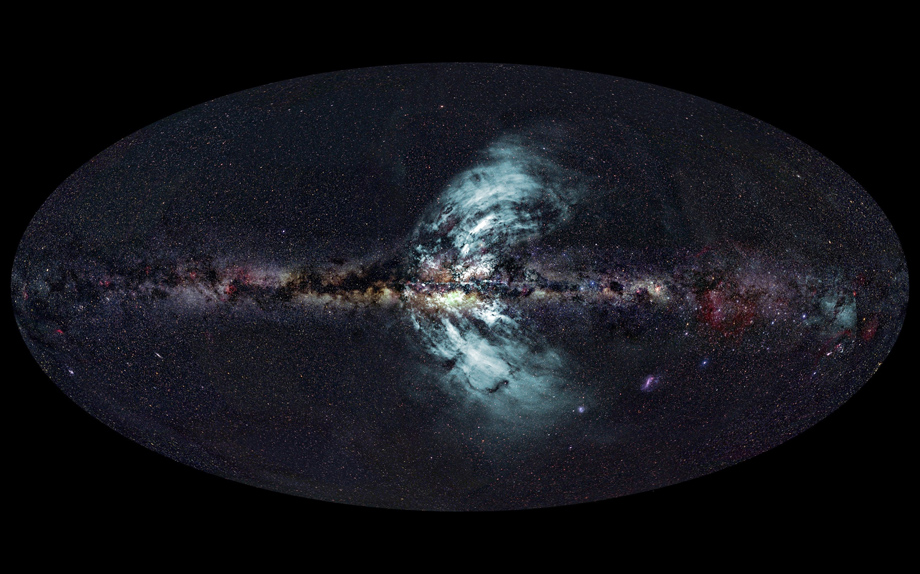
Photo by Ettore Carretti, CSIRO (radio image); S-PASS survey team (radio data); Axel Mellinger, Central Michigan University (optical image); Eli Bressert, CSIRO (composition)
Our Milky Way galaxy is a vast collection of stars, gas, and dust, spread out into flat disk with embedded spiral arms and a central hub of stars like a squashed ball. You wouldn’t think that a structure half the size of the galaxy itself could hide from us, but that’s exactly what we found out: Two vast bubbles of gas are being blown out of the galaxy’s center, and they’re each 50,000 light years long! The picture above shows them (in blue) superposed on an all-sky image of the Milky Way; if you could see in radio light they'd stretch halfway across the sky. We’ve seen hints of these gigantic fountains before, but the Parkes radio telescope in Australia provided astronomers with key information about them, including their cause: huge episodes of star birth, which pump tremendous amounts of energy into the galaxy. How much energy? The equivalent of a million stars exploding. That kind of power is staggering, and happily is going on at a distance of 250 quadrillion kilometers away; far enough that they can't affect us physically. But we can still see them, study them, and marvel at them.
Gamma-Ray Burst Hulk Smashes Record
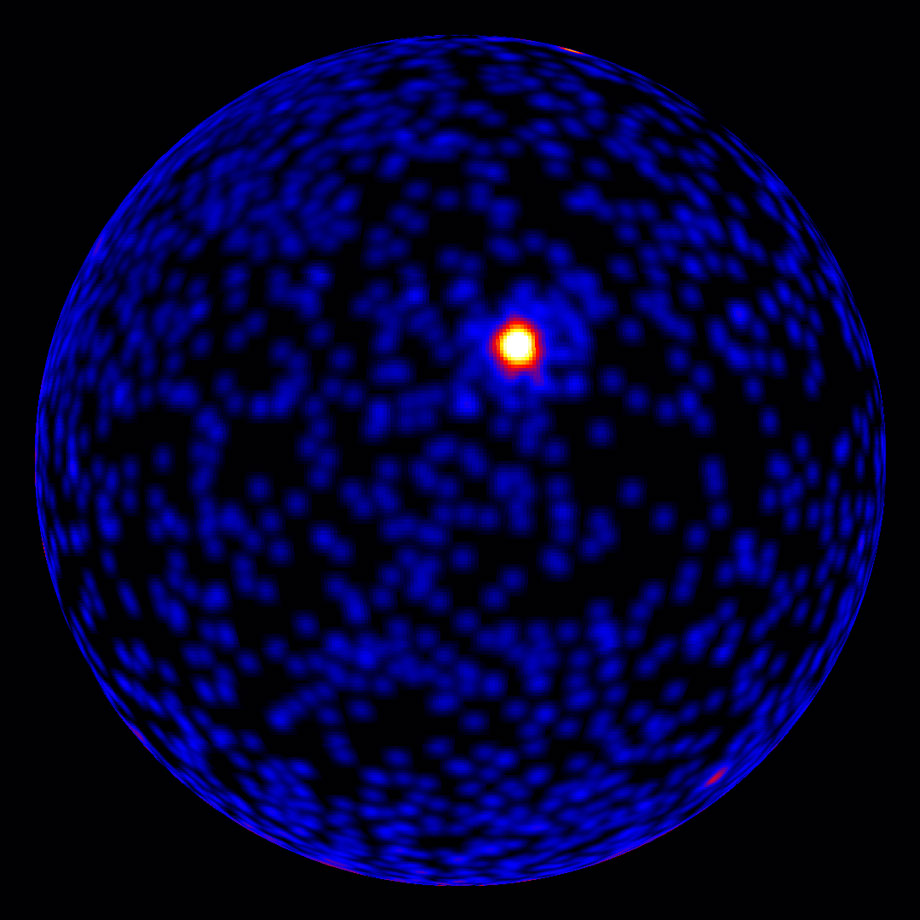
Photo by NASA/DOE/Fermi LAT Collaboration
Gamma-ray bursts are the most violent events in the Universe: During the death of a massive star, its core collapses into a black hole, generating energies so huge they defy adjectival description. This energy is focused into twin beams that drill out from the star and march across space, cosmic blowtorches so luminous they can be seen clear across the Universe. On April 27, 2013, the light from just such a burst reached Earth. It was from the relatively nearby distance of 3.6 billion light years—though still a quarter of the way across the cosmos—so it appeared incredibly bright to our orbiting observatories like Fermi, which took the image above. Gamma rays are the highest energy form of light, and this GRB spewed them out at such a rate that at its peak 100,000 of them were seen every second by the Swift satellite. One of these gamma rays was the highest-energy photon ever seen from a GRB, with an energy 35 billion times that of a photon of visible light. This burst also lasted for hours, allowing many ground-based telescopes to observe it as well.
The Milky Way’s Youngest Black Hole … Maybe
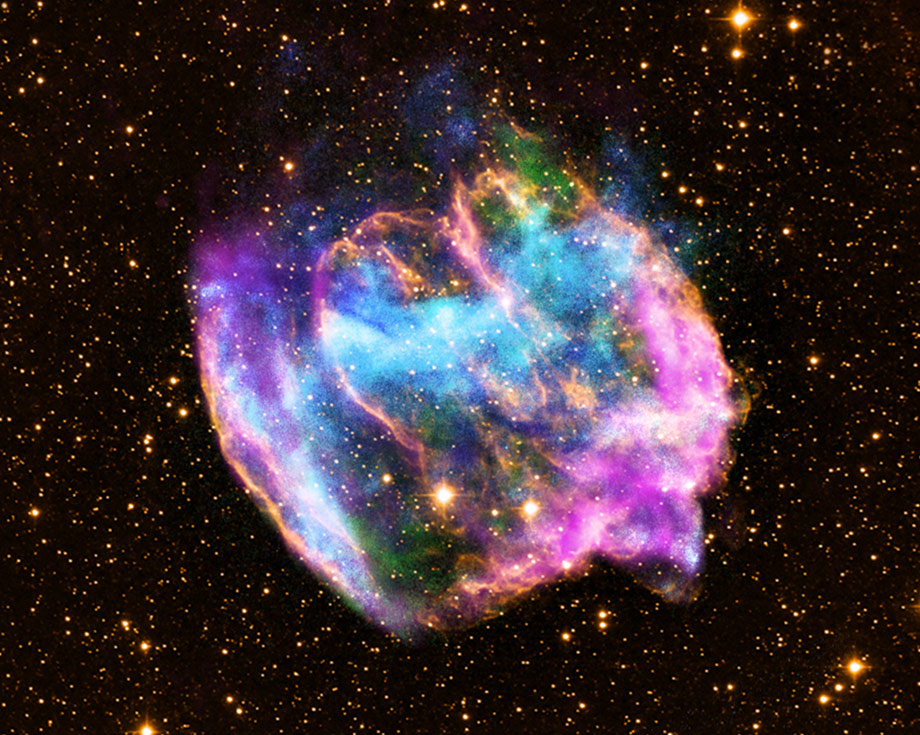
Photo by NASA/CXC/MIT/L.Lopez et al. (X-ray); Palomar (infrared); NSF/NRAO/VLA (infrared)
Twenty-six thousand light years away is the odd nebula W49B. This barrel-shaped gas cloud is the expanding debris from an exploding star, a supernova. The image above is a combination of X-rays (taken by NASA's Chandra X-Ray Observatory, shown in green and blue) with infrared (Palomar observatory, yellow) and radio (VLA, magenta) emission. Most of the time these exploding stars leave behind an über-dense neutron star, but given the youth of this cloud—about 1,000 years—any neutron star would be bright in X-rays, yet none are seen. That strongly implies this titanic event created a black hole, which would make it very likely the youngest such object in the galaxy. The shape of W49B is interesting, too; it’s elongated, and the gas inside is not distributed evenly, meaning it was not a spherical explosion. This in turn implies it may have erupted more like a gamma-ray burst, one of the most luminous and violent explosions in the Universe. However, astronomers aren’t sure about the details of what happened to create this 30-light-year-wide debris cloud. It's a bit of a mystery, which scientists love. Puzzles are fun!
We All Deserve the Universe
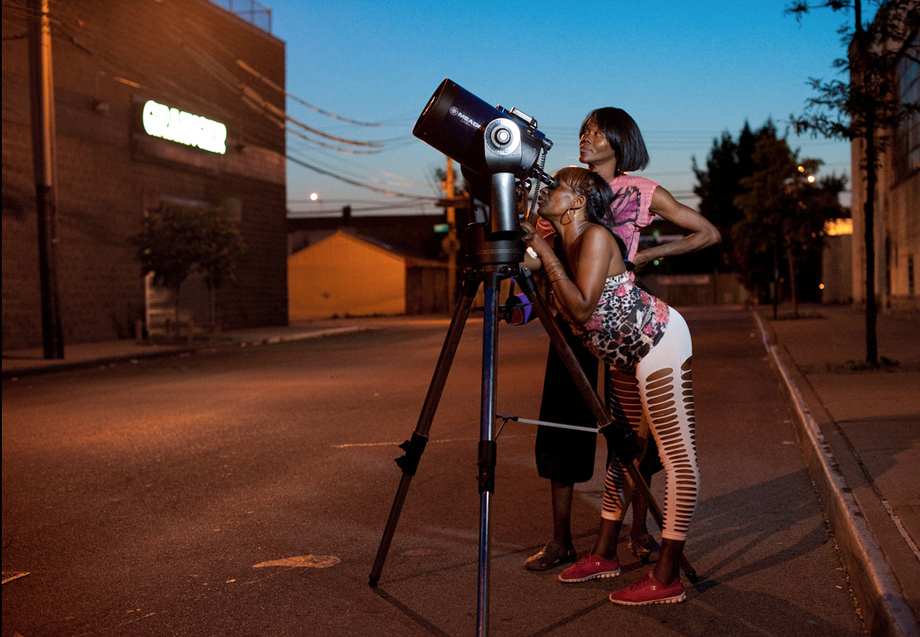
Photo by Chris Arnade
Chris Arnade is a photographer who captures scenes of humanity that many might find distressing. He travels around the high-crime area of Hunts Point in the Bronx to photograph the people who live there, specifically drug addicts and prostitutes. Why would I include a photo from this series in my list of best astronomy photos of the year? As I wrote at the time:
But one [photo] in particular struck me. It stands out. Among the many photos of drawn and worn faces, there is a picture showing two women who are not stooped. One stands tall, gazing upward. The other is bent at the waist, but it is not from exhaustion or addiction.
She’s looking into the eyepiece of a telescope.
The two women are Takeesha and Deja, prostitutes befriended by Arnade. He spotted them early one evening and got an idea. He took out his telescope and showed them Saturn. As Arnade told me, “For me it was about bringing together two of my loves: Astronomy (I got my PhD in Physics from Johns Hopkins) and, well, addiction and prostitutes (which is my present focus). I have to say Takeesha's reaction made my week. She truly was amazed."
As much as I love the Universe in all its beauty and wonder, this photo speaks to why I do what I do far more than any Hubble picture of a galaxy or space probe photo of a planet. Those objects are out there, they exist, but it is our joy of seeing them, knowing them, understanding them, that makes this such a noble endeavor. And when we see them for the first time, let the light that has traveled so unimaginably far enter our eyes, we too become part of what we study.
Ad aspera ad infinitum.
The Long Shadows Over the Earth
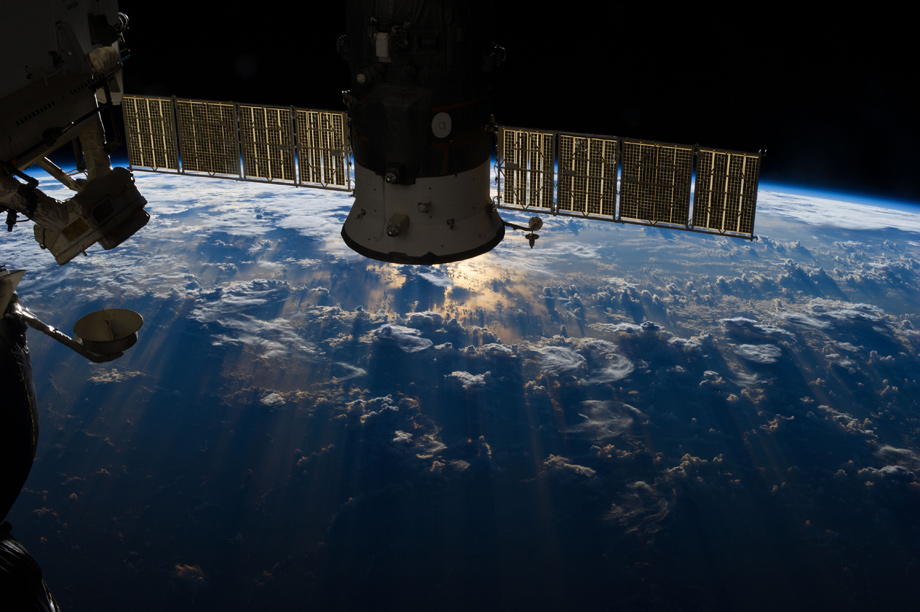
Photo by NASA
Orbiting 370 kilometers (230 miles) above the Earth, the International Space Station circles our planet 18 or more times a day. That means it sees 18 sunrises and 18 sunsets during the same time we flatlanders only see one of each. With 36 times the gawking capability, it’s no surprise that sometimes the astronauts see the Sun meet the horizon with surpassing beauty. Such was the case on July 4, 2013, when the above photo was snapped*. It was taken when the Sun was low to the horizon, and storm clouds were forming over the Atlantic Ocean off the coast of Brazil. The towering clouds cast long, long shadows over the water, a clear sign the Sun was low.
But is this a sunrise or a sunset? The funny thing is, I’m not sure. There’s no clear coastline or landmark to give us a clue if we’re looking east or west here. Perhaps an expert could figure it out by knowing the position of the mated Russian Progress module seen across the top of this image coupled with an understanding of the direction and attitude of the ISS as it orbits the Earth …
But I actually rather like the ambiguity itself as a metaphor for the end of the year. The Sun rises and sets, a year ends and a new one begins, winter rolls into spring and the year begins anew.
What will we see in 2014? I can’t tell you exactly, but I can say this with utter confidence: We’ll see farther, better, and perhaps a touch more clearly than we did the year before. Astronomy and space exploration extend our sight as far as our imagination can reach, providing reality, science, and understanding to what we think. And that is why I love them so dearly.
Related Posts:
Top 14 Solar System Pictures of 2011
Top 16 Space Pictures of 2011
Top 10 Astronomy Pictures of 2010 - Runners Up
The Top 14 Astronomy Pictures of 2010
Top 10 Astronomy Pictures of 2009
Top 10 Astronomy Pictures of 2008 (gallery currently offline; we’re working on it!)
Top 10 Astronomy Pictures of 2007 - Runners Up
Top 10 Astronomy Pictures of 2007
Top 10 Astronomy Pictures of 2006
Correction, Dec. 23, 2013: A previous version of this post said the photo of "long shadows over the Earth" was taken in the future—2103. It was taken in 2013.

